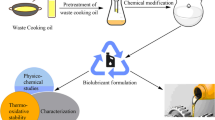Abstract
The aim of present work was to obtain improved physicochemical properties and rheological characteristics of epoxidized waste cooking oil (WCO epoxide). To accomplish the objective, structural modification of waste cooking oil (WCO) was carried out by in situ epoxidation technique at 60 °C for 10 h with hydrogen peroxide (H2O2)-to-ethylenic unsaturation molar ratio, 1.5; acetic acid-to-ethylenic unsaturation molar ratio, 0.5 and 15 wt% catalyst (Amberlite IR-120, heterogeneous cation-exchange resin) loading. The product was confirmed by 13C-NMR, oxirane oxygen analysis, iodine value (IV). Thermo-oxidative stability of WCO epoxide and servo hydraulic lubricant (conventional) was determined by thermo-gravimetric analysis in inert as well as oxygen atmospheres and compared. Further, in order to improve WCO epoxide physicochemical properties, it was blended with waste cooking oil methyl esters (WCOME). All significant physical and rheological properties of WCO, WCO epoxide and their blends were estimated. Outcomes of the study revealed significant improvement in the thermo-oxidative stability and physicochemical properties of WCO epoxide compared to unmodified WCO and conventional hydraulic lubricant from servo.








Similar content being viewed by others
References
Lathi, P.S., Mattiasson, B.: Green approach for the preparation of biodegradable lubricant basestock from epoxidised vegetable oil. Appl. Catal. B Environ. 69(3–4), 207–212 (2007)
Hwang, H.S., Erhan, S.Z.: Synthetic lubricant basestocks from epoxidized soybean oil and Guerbet alcohols. Ind. Crop. Prod. 23(3), 311–317 (2006)
Salimon, J., Salih, N.: Chemical modification of oleic acid oil for bio-lubricant industrial applications. Aust. J. Basic Appl. Sci. 4(7), 1999–2003 (2010)
Campanella, A., Fontanini, C., Baltanas, M.A.: High yield epoxidation of fatty acid methyl esters with performic acid generated in situ. Chem. Eng. J. 144(3), 466–475 (2008)
Erhan, S.Z., Sharma, B.K., Liu, Z., Adhvaryu, A.: Lubricant basestock potential of chemically modified vegetable oils. J. Agri. Food Chem. 56(19), 8919–8925 (2008)
Borugadda, V.B., Goud, V.V.: Synthesis of waste cooking oil epoxide as a bio-lubricant basestock: characterization and optimization study. J. Bioprocess Eng. Biorefinery 3, 1–14 (2014)
Mazumdar, P., Borugadda, V.B., Goud, V.V., Sahoo, L.: Physico-chemical characteristics of Jatropha curcas L. of North East India for exploration of biodiesel. Biomass Bioenergy 46, 546–554 (2012)
Wanger, H., Luther, R., Mang, T.: Lubricant base fluids on renewable raw materials their catalytic manufacture and modification. Appl. Catal. A Gen. 221(1–2), 429–442 (2001)
Salimon, J., Salih, N., Yousif, E.: Improvement on pour point and oxidative stability of synthetic esters basestocks for bio-lubricant applications. Arabian J. Chem. 5(2), 193–200 (2012)
Choe, E., Min, D.B.: Chemistry of deep-fat frying oils. J. Food Sci. 72(5), 77–86 (2007)
Siddique, B.M., Ahmad, A., Ibrahim, M.H., Hena, S., Rafatullah, M., MohdOmar, A.K.: Physico-chemical properties of blends of palmolein with other vegetable oils. Grasasy Aceites 61(4), 423–429 (2010)
Madankar, C.S., Dalai, A.K., Naik, S.N.: Green synthesis of bio-lubricant basestock from canola oil. Ind. Crops Prod. 44, 139–144 (2013)
Acknowledgments
VBB thanks Dr. Vimal Katiyar and Mr. Arvind Gupta for providing the GPC facility at CoE, SusPol and CIF, IIT Guwahati, for furnishing NMR facility and FIST, DST, SR/FST/ETII-028/2010 for supplying interfacial rheometer.
Author information
Authors and Affiliations
Corresponding author
Rights and permissions
About this article
Cite this article
Borugadda, V.B., Goud, V.V. Physicochemical and Rheological Characterization of Waste Cooking Oil Epoxide and Their Blends. Waste Biomass Valor 7, 23–30 (2016). https://doi.org/10.1007/s12649-015-9434-8
Received:
Accepted:
Published:
Issue Date:
DOI: https://doi.org/10.1007/s12649-015-9434-8




